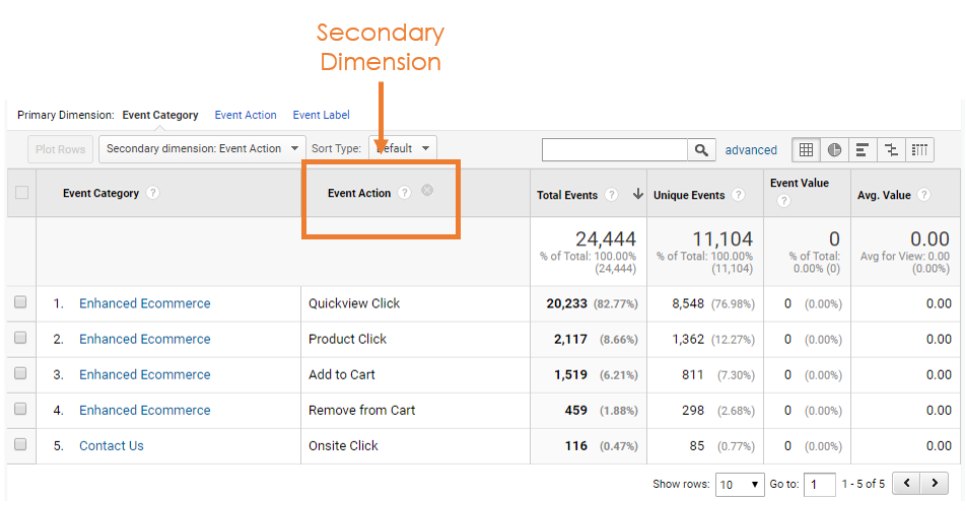Discovering Google Analytics Secondary Dimension: Strategies and Advantages
Wiki Article
Opening the Power of Secondary Dimension Analytics for Boosted Data Insights and Decision-Making
In the world of information analytics, primary dimensions commonly take the limelight, but real deepness of understandings lies within the realm of additional measurements. These added information factors supply a nuanced perspective that can illuminate patterns and connections not conveniently apparent in the beginning glimpse. By using the power of additional measurement analytics, companies can introduce hidden trends, uncover correlations, and extract much more significant verdicts from their data. The potential for enhanced decision-making through the utilization of these secondary dimensions is vast, promising a deeper understanding of complex information sets and leading the method for even more informed strategic choices.
Value of Additional Dimensions
Discovering the relevance of additional dimensions in analytics introduces the concealed layers of data understandings critical for educated decision-making in numerous domain names. Additional dimensions give a much deeper understanding of primary information by using additional context and viewpoints. By integrating secondary measurements into analytics, companies can draw out more nuanced and thorough insights from their datasets.One key relevance of additional measurements is their capability to sector and categorize main information, enabling an extra in-depth evaluation of particular subsets within a dataset. This division allows businesses to determine patterns, fads, and outliers that may not appear when taking a look at the information overall. Second dimensions assist in uncovering connections and dependencies between various variables, leading to more accurate projecting and predictive modeling - secondary dimension.
In addition, second dimensions play an important duty in improving information visualization and coverage. By including second dimensions to visualizations, such as charts or graphs, analysts can produce extra useful and insightful representations of data, helping with much better interaction of searchings for to stakeholders. Generally, the assimilation of second measurements in analytics contributes in opening the complete possibility of information and driving evidence-based decision-making.
Trick Advantages of Making Use Of Second Measurements
Making use of additional measurements in analytics uses organizations a tactical advantage by boosting the deepness and granularity of information understandings. One essential benefit of incorporating secondary measurements is the ability to section and filter data, enabling a more detailed evaluation of details facets within a dataset. This segmentation enables organizations to obtain a much more nuanced understanding of their audience, performance metrics, and other important data factors. By studying data using second dimensions such as time, location, tool kind, or user demographics, companies can discover patterns, trends, and relationships that may otherwise continue to be covert.Furthermore, the utilization of second dimensions enhances the context in which primary data is interpreted. It supplies an extra thorough view of the partnerships between various variables, enabling organizations to make enlightened decisions based on an extra holistic understanding web of their information. Furthermore, secondary dimensions promote the identification of outliers, anomalies, and locations for optimization, ultimately resulting in extra effective techniques and boosted outcomes. By leveraging secondary measurements in analytics, companies can harness the full capacity of their information to drive far better decision-making and achieve their company goals.
Advanced Information Evaluation Strategies
A deep dive right into advanced data analysis techniques reveals advanced techniques for drawing out beneficial understandings from intricate datasets. One such strategy is artificial intelligence, where formulas are used to recognize patterns within information, anticipate results, and make data-driven choices. This approach enables the automation of logical version structure, allowing the processing of large volumes of data at a quicker pace than traditional methods.An additional innovative strategy is predictive analytics, which uses statistical formulas and artificial intelligence techniques to anticipate future results based on historical information. By examining patterns and patterns, businesses can prepare for client behavior, market fads, and prospective dangers, empowering them to make aggressive decisions.
Furthermore, message mining and belief analysis are beneficial methods for removing understandings from unstructured information sources such as social media remarks, client reviews, and study responses. By assessing text data, organizations can comprehend customer point of views, determine arising trends, and boost their services or items based on responses.
Enhancing Decision-Making With Second Dimensions

Enhancing decision-making with secondary dimensions allows organizations to make more notified and targeted critical choices. For instance, by segmenting consumer information based on additional measurements like acquiring background or involvement levels, business can tailor their advertising and marketing strategies to particular audience sections, bring about boosted conversion rates and customer fulfillment. Moreover, secondary dimensions can aid determine relationships and connections in sites between various variables, allowing companies to make data-driven decisions that drive development and profitability.
Implementing Secondary Measurement Analytics
When incorporating second dimensions in analytics, companies can unlock much deeper insights that drive critical decision-making and improve total performance. This requires comprehending the details concerns the organization looks for to respond to and the information points called for to address them.
Furthermore, organizations need to leverage progressed analytics devices and technologies to enhance the procedure of incorporating secondary dimensions. These devices can automate data handling, analysis, and visualization, enabling companies to concentrate on interpreting insights instead than hand-operated information manipulation.
Final Thought
In final thought, additional dimension analytics play an important function in improving data insights and decision-making procedures. By making use of innovative data analysis techniques and implementing second measurements successfully, organizations can open the power of their information to drive calculated company decisions.In the world of information analytics, main dimensions often take the limelight, however the true depth of understandings lies within the realm of second measurements.Using second measurements in analytics provides companies a critical advantage by enhancing the deepness and granularity of information insights. By leveraging second dimensions in analytics, organizations can harness the complete potential advice of their information to drive much better decision-making and achieve their organization goals.
Applying information recognition processes and normal audits can assist preserve data top quality and integrity.
By making use of innovative data analysis techniques and executing additional dimensions successfully, organizations can open the power of their data to drive calculated business choices.
Report this wiki page